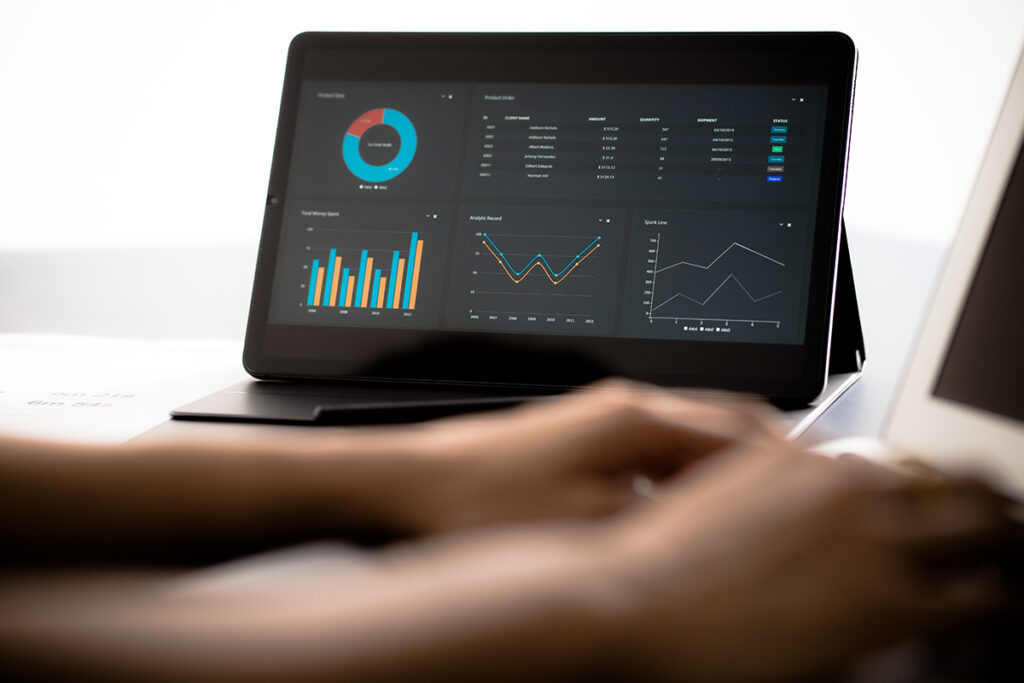Digital Media Buying is the process of purchasing ad placements in various digital channels like websites, social media platforms, streaming services, and apps. Its importance stems from the fact that strategically purchasing ad placements can significantly impact a campaign’s success by ensuring that the right audiences see the ads at the right times. By doing this well, we, at Raincross, can help your business achieve optimal results for your budget, secure ideal ad placements, and reach your target audience.
Introduction to Digital Media Buying
Are you wondering how to amplify your online presence and set your business on the fast track to success? If so, you’re in the right place. Welcome to the complex yet fascinating world of digital media buying. In the simplest terms, digital media buying is about picking the right digital channels to place your ads, at the right time, targeting the right audience. But, and there’s always a ‘but,’ it’s more than just buying ad spaces.
Definition and Importance of Digital Media Buying
At its core, digital media buying is a mixture of science and art. It is about buying media space to run advertisements that reach your target audience effectively and efficiently. It includes the negotiation for price, ad placements, and the research into the best new channels for ad placement.
Why is it important, you ask?! Well, imagine having a compelling ad but placing it in the wrong space where none of your target consumers will see it. A waste, right? That’s where we come in. Digital media buying is not an overlooked aspect of your marketing plan but a significant player in defining your brand’s online presence.
The Role of a Digital Media Buyer
As media buyers, our role is to secure the most beneficial locations and timings for your ads to maximize their effectiveness with specific audiences. Media buyers work directly with media planners to create an optimal media plan, adhering to the campaign budget parameters.

Stay tuned, as in the next sections, we’ll delve deeper into the process of digital media buying, the steps involved, and how your business can master this essential component of online marketing. Whether you’re just starting out or looking to refine your current strategy, we’ve got you covered. Let’s chart the digital media scape together; after all, your success is our success.
Understanding the Digital Media Buying Process
Digital media buying is a dynamic and multi-step process that requires a strategic approach. As we journey through it, we’ll delve into the steps involved, the difference between direct and programmatic buys, and the impact of cookies and Apple’s AppTrackingTransparency on media buying.
Steps Involved in Digital Media Buying
The digital media buying process encompasses several key steps that, when followed, can lead to a successful advertising campaign.
- Budget Allocation: First, determine what percentage of your total budget will be spent on guaranteed inventory (specific amount of inventory purchased) versus non-guaranteed inventory (unspecified amount of inventory purchased at a discounted rate).
- Request for Proposals (RFPs): Send RFPs to media outlets, evaluate the potential of each mix to maximize campaign performance.
- Order Finalization: Create an insertion order (IO) to finalize the order.
- Ad Trafficking: Traffic the creative to the selected media outlets, ensuring each ad is appropriately sized for its placement.
- Campaign Launch: Launch the campaign ensuring metrics are in place to measure results.
- Monitoring and Optimization: Monitor metrics from media outlets or channels, as well as internal insights, to gauge success, making tweaks as necessary.
- Reconciliation: Reconcile spend against the budget detailed in the media plan and negotiate “make goods” for any under-delivering ads.
Direct Buy vs Programmatic Buy
There are numerous ways to purchase media, but two of the most common methods are direct buying and programmatic buying.
Direct Buying involves purchasing ads directly with a specific channel or publisher. It allows advertisers to have more control over where their ads are placed and the quality of the ad inventory. However, its targeting capabilities can be limited due to restricted access to data on user behavior.
On the other hand, Programmatic Buying uses automated technology to buy and sell digital ads. It allows for real-time bidding and targeting of ad inventory, making it possible to reach specific audiences with greater precision and efficiency. Programmatic buying can overcome some of the limitations of direct buying, but it also faces challenges such as ad fraud and viewability issues.
The Impact of Cookies and AppTrackingTransparency on Media Buying
In the digital world, cookies play a crucial role in tracking user behavior, which is vital for targeted advertising. However, with increasing privacy regulations and the move towards a cookie-less world, the digital media buying process is bound to face challenges.
Similarly, Apple’s AppTrackingTransparency feature allows users to opt-out of tracking, impacting the way advertisers reach their audience on Apple devices. This shift towards user privacy is driving the need for alternate targeting strategies and innovative solutions in the realm of digital media buying.
Understanding the digital media buying process is the first step towards navigating the ever-evolving digital advertising landscape. At Raincross, we’re here to help you through every step of this journey, ensuring your business achieves its online marketing goals. Stay tuned as we delve deeper into the components of a successful digital media strategy in the next section.
Key Components of a Successful Digital Media Strategy
A successful digital media strategy is like a well-tuned orchestra, with each instrument playing its part to create a harmonious outcome. In digital media buying, these ‘instruments’ are the goals you set, the channels you choose, and the measurement systems you implement. Let’s break down each of these components further.
Setting Goals: Awareness, Conversion, and Branding
Before embarking on any digital media buying journey, you need to define your destination. In other words, you need to set clear and measurable goals. These goals typically fall into one of three categories: awareness, conversion, or branding.
Awareness Goals: These goals focus on introducing your brand to new users. You might measure success in terms of impressions, clicks, CPM (cost-per-mille), and branded search queries. Creating awareness is a marathon, not a sprint. Consistent, high-quality messaging over time is key to building brand recognition.
Conversion Goals: These goals are all about driving specific customer actions, such as making a purchase or filling out a form on your website. Key metrics for these goals include conversions, cost per conversion, conversion rate, and ROAS (Return on Ad Spend).
Branding Goals: Branding goals aim to keep your brand front and center in the minds of your current customers. You may measure success through metrics like followers, social engagement, and branded search queries.
Choosing the Right Channels: Search, Social, Display, and Video
Just as a musician carefully selects their instrument, you need to choose the right advertising channels for your goals. From search and social to display and video, each channel offers unique opportunities to reach your target audience.
Search: Search engine marketing, both organic (SEO) and paid (SEM), is a crucial part of any digital media strategy. It helps drive high-quality, relevant traffic to your website.
Social: Social media platforms like Facebook, Instagram, and Twitter offer targeted advertising opportunities. They are effective for both fostering new customer relationships and strengthening existing ones.
Display: Display ads, including banners and videos, increase brand visibility and engage users with enticing visuals.
Video: Video ads on platforms like YouTube can be incredibly engaging and help to convey your brand message effectively.
Measurement Systems: Metrics for Success
Lastly, you need to set up measurement systems to track your campaign’s success. This involves identifying key performance indicators (KPIs) that align with your goals. For example, if you’re focusing on SEO, you might track rankings, traffic, and conversions, while a social media campaign may require tracking impressions, clicks, and follower growth.
It’s not enough to just set up these metrics; you also need to actively monitor and adjust your strategy based on your findings. By doing so, you can ensure that your digital media buying strategy is not only driving results but also improving over time.
At Raincross, we’re dedicated to helping businesses like yours navigate the complexities of digital media buying. By setting clear goals, choosing the right channels, and tracking your success, you can make the most of your digital advertising efforts. In the next section, we’ll explore the tools and platforms that can help you achieve these goals.
Tools and Platforms for Digital Media Buying
Once you’ve established your digital media strategy, the next step is to select the right tools and platforms for your media buying. This decision is crucial because the effectiveness of your campaign largely depends on the platform’s reach, targeting capabilities, and analytics.
Overview of Demand-Side Platforms, Supply-Side Platforms, and Ad Exchanges
In the digital media buying landscape, we primarily deal with three types of platforms: Demand-Side Platforms (DSPs), Supply-Side Platforms (SSPs), and Ad Exchanges.
Demand-Side Platforms (DSPs) are tools used by advertisers (like us at Raincross) to buy ad space programmatically from publishers. They automate the purchasing process by allowing us to bid on ad space in real time, ensuring we get the best price and placement for our ads.
On the other hand, Supply-Side Platforms (SSPs) are used by publishers to sell their ad space. They automate the selling process by connecting with multiple DSPs, broadening the pool of potential advertisers.
Ad Exchanges are digital marketplaces where DSPs and SSPs meet. They facilitate the buying and selling of ad space across various networks, including the Google Display Network (GDN) and other programmatic platforms.
Tips and Best Practices for Effective Digital Media Buying
In order to maximize the impact of your digital media buying strategy, it’s crucial to follow certain practices and tips. These include strategizing and identifying your target audiences, setting up campaigns and tracking results, and optimizing ads for maximum effectiveness.
Strategizing and Identifying Target Audiences
The first step in any digital media buying process is strategizing and identifying your target audience. You need to understand who your ideal customer is, what they’re interested in, and where they spend their time online. This will allow you to tailor your ad placements to reach the right people at the right time.
One of the key benefits of digital media is the ability to target specific audiences based on demographics, interests, and behaviors. As a result, businesses can reach the most relevant potential customers, which can result in higher conversion rates and a better return on investment (ROI) .
Setting Up Campaigns and Tracking Results
Once you know who your target audience is, the next step is to set up your campaigns. This involves choosing the right channels (such as Google, Facebook, Instagram, or TikTok), setting a budget, and creating compelling ad content.
But setting up campaigns is only half the battle. It’s also vital to track the results of your campaigns in real time. Digital media provides businesses with real-time monitoring and optimization capabilities, allowing you to make adjustments to optimize your campaigns’ effectiveness .
By tracking metrics such as impressions, clicks, and conversions, you can measure the effectiveness of your campaigns and make data-driven decisions. This can help you improve your future campaigns and maximize your ROI.
Optimizing Ads for Maximum Effectiveness
Lastly, it’s important to continually optimize your ads for maximum effectiveness. This involves adjusting your bidding strategy, blocking select domains, and making sure your marketing mix and creatives are working together to tell a complete story .
Additionally, don’t forget to experiment with new features and channels. As we at Raincross have pointed out, testing new channels can help you reach more customers and improve your PPC strategy .
Finally, always prioritize brand safety and trust when working with media buyers and digital partners. This will ensure that your brand’s reputation remains intact and your advertising efforts are successful .
Digital media buying can be a powerful tool for growing your business, but only if it’s done right. By following these tips and best practices, you can ensure that your digital media buying strategy is as effective as possible.
The Future of Digital Media Buying
Digital media buying has undeniably evolved over the years. But what does the future hold? As businesses and technologies continue to evolve, so will the strategies and techniques for effective media buying.
Trends and Predictions in the Digital Media Buying Space
Greater Personalization: The future of digital media buying lies in the ability to personalize ads to the highest degree. Tools like Google’s Customer Match foreshadow a future where businesses can deliver specific messages to their customers based on their unique preferences and behaviors.
Rise of Programmatic Direct: As per Raincross, programmatic direct, which allows advertisers to purchase ad inventory directly from publishers, is on the rise. This method can offer advertisers more control over where their ads are placed.
Expansion of Social Media Buy Buttons: The integration of buy buttons in social media platforms is expected to become the norm. Platforms like Facebook and Pinterest have already introduced the “Buy Now” features, allowing users to make purchases directly from their apps.
Optimization for Digital Assistants: The rise of digital assistants like Siri, Google Now, and Cortana is redefining the search process. As these assistants become more widely adopted, businesses will need to optimize their website’s information to be easily found when these assistants perform a search.
How Raincross is Innovating in Digital Media Buying
At Raincross, we’re always looking ahead. We understand the dynamic nature of digital media buying and are committed to staying at the forefront of the latest trends and technologies.
Embracing Programmatic Advertising: We’re harnessing the power of programmatic advertising, using automated technology to buy and sell advertising space in real-time. This enables us to target specific audiences and reach them at the right time and place.
Optimizing for Mobile: Recognizing the dominance of mobile, we’re optimizing our clients’ ads for mobile devices. We ensure that every ad we create and every campaign we run is designed with a “mobile-first” approach.
Investing in Social Advertising: We’re setting budgets for complete social advertising strategies, capitalizing on the vast reach and targeting capabilities of social media platforms.
As we forge ahead, we remain committed to delivering personalized and effective digital media buying strategies that drive growth for our clients. With our finger on the pulse of digital trends, we’re ready to navigate the future of digital media buying, delivering the results our clients need.
Conclusion: Navigating the Digital Media Buying Landscape
As we’ve explored in this guide, digital media buying is an intricate process that requires a deep understanding of your target audience, a strategic approach to campaign planning, and a keen eye for analyzing and optimizing results. It’s a dynamic field that’s constantly evolving, with new platforms, technologies, and trends emerging regularly.
Whether you’re buying ad space directly from publishers or leveraging programmatic buying to target specific audiences, it’s crucial to keep in mind the end goal: reaching the right audience, at the right time, with the right message, and at the right cost.
The key to successful digital media buying isn’t just about the amount you spend, but how effectively you spend it. By focusing on quality placements and audience-aligned creatives, you can maximize the effectiveness of your ad spends. As a bonus, this approach isn’t just financially prudent but also environmentally responsible, aligning with global sustainability efforts.
In digital media buying, the landscape is shifting. Traditional methods are being replaced by more efficient and effective strategies. As such, continually adapt and innovate. For instance, the surge of Connected TV in programmatic advertising represents a significant shift, aligning with the decline in traditional TV viewership and the rise of ad-supported streaming platforms. By utilizing various channels such as social media, streaming, digital out-of-home, and display advertising, advertisers can create comprehensive omnichannel experiences, engaging audiences effectively across their preferred content platforms.
As we navigate this shifting landscape, we at Raincross are committed to staying at the forefront of these changes. We’re constantly exploring new strategies and technologies to ensure that our clients’ ads reach their target audience in the most effective and efficient way possible. We’re not just media buyers; we’re your strategic partners in digital advertising, helping you to navigate this complex landscape and achieve your business goals.
We hope this guide has provided a comprehensive overview of digital media buying and its vital role in today’s digital marketing landscape. For more insights and tips on digital advertising and marketing, be sure to check out our blog or explore our services. And if you’re ready to take your digital media buying strategy to the next level, contact us today. We look forward to helping you navigate the digital media buying landscape and achieve your business objectives.







About The Author: Mysti French
Mysti French is a rockstar content writer! Before joining Raincross, she wrote and developed site content for such sites as Organize.com, MonkeySports, Marketing Instincts and Brenner-Feidler.
Mysti grew up in San Diego before moving to Perris, CA. She graduated from Cal State Hayward (later changed to Cal State East Bay) with a BA in English and Political Science.
More posts by Mysti French